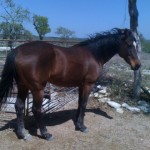 Despite a solid holistic horse health program my horses were not slick and shiny and I was really annoyed by this. I pride myself on taking the best possible care of my horses but after 18 months of drought followed by a hard, wet winter my horse’s coats looked like crap. The hair was long, dry, brittle and curly. This was unacceptable!
Despite a solid holistic horse health program my horses were not slick and shiny and I was really annoyed by this. I pride myself on taking the best possible care of my horses but after 18 months of drought followed by a hard, wet winter my horse’s coats looked like crap. The hair was long, dry, brittle and curly. This was unacceptable!
What things make a hair coat look bad:
Lack of food – Even with a good holistic horse health program, if horses are not fed enough calories in harsh weather conditions they will lose condition and develop rough hair. My horses were fat and energetic and they eat free choice hay. This was not their problem.
Lack of minerals – Trace minerals such as copper and zinc have a lot to do with the shininess of the hair. Many conventionally grown feeds for horses are deficient in trace minerals. In addition to low levels in the diet, over vaccination can sometimes interfere with the healthy bacteria in a horse’s gut and cause minerals to be poorly absorbed.
With their holistic horse health program, my horses get a whole food trace mineral supplement and digestive support from packets of bluegreen algae, probiotics and enzymes and I don’t over vaccinate. I was suspicious of my grass hay. My supplier strives to get the best quality hay for horses but I have come to distrust all conventionally grown feeds for horses. I believe the chemicals used on the fields are not good. I recently was told that horse manure is bad for compost because the herbicides will persist and kill garden plants. These chemicals may also affect our horses.
Because of the drought and hard winter my horses ate more hay than ever before. Interestingly, my mare, Cerise, gets more alfalfa and less grass hay and she looks the best of all the group.
Worms – Worms can compete for nutrition and damage the gut wall, which affects absorption of nutrients. I have a solid holistic horse health deworming program but to be safe I did fecal checks on my horse’s manure. I found very few worm eggs but I gave double dose strongid just in case they had tapeworms. No change in their hair.
Fats – Horses need good quality fat in the diet to make the hair shiny. My horses have been on a low fat feed for horses. Normally they get enough fat from the grass they eat but not this year. I have been feeding a TBS twice a day of chia seeds as a fat source but I doubled that when I saw the rough coats. I also started giving all the horses more alfalfa until the spring grass comes out.
Metabolic conditions such as cushings or insulin resistance – I am comfortable that I do not have these things going on since all my horses look rough. If only one horse was bad I would immediately do some lab tests to rule these conditions out.
I have been on the new program of increased fat and extra alfalfa for only a week and the hair is starting to get soft and shed out on all the horses, especially Cerise. The grass has not changed much so I am confidant my adjusted holistic horse health program is working. I will cut back on the seeds and alfalfa as the grass gets greener. Now I can take my horses back out in public. Madalyn
Madalyn,
I wondered if you are still feeding Aussie Logic? I did for over a year (and was very happy with it mostly) until I had a mare that colicked within an hour of eating 2 days in a row… which may have had other issues. But I ask because their coats at that point looked duller than I like. When I switched back to a minimum amount of a processed feed, their coats started gleaming again. It was almost as though they were missing natural oils/fats of some sort. When I wet the Aussie Logic for a senior horse, and then leftovers dried on the feed bowl, the leftovers felt rough/hard like cement. That was another reason I switched back.
Liz,
I do feed the Aussie Logic, which is low fat, but the majority of my feeding program is grass or hay. I think the added fat made the difference. Mine would normally get some fat from the forage but they have not had this with our bad weather. Madalyn